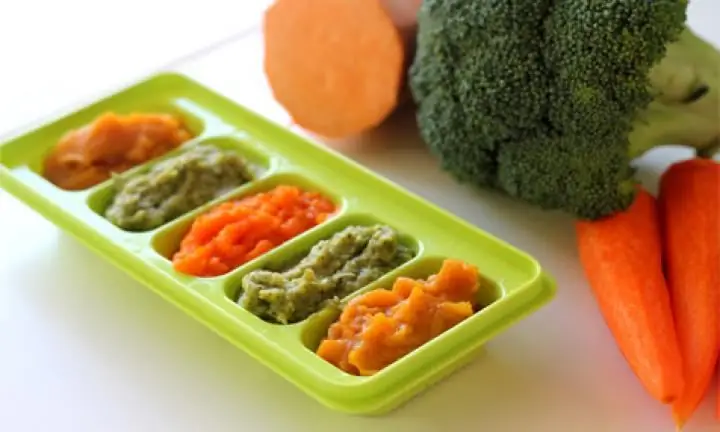2025 Author: Priscilla Miln | [email protected]. Last modified: 2025-06-01 05:14:29
At about 4-5 months, the baby begins to lack the vitamins and minerals that enter his body along with breast milk or formula. Therefore, it is then that the time comes for the introduction of complementary foods with vegetables, the sequence of which will be discussed later in the article.
When the time comes
For a growing baby, it is important that nutrients enter his body. Until a certain time, breast milk satisfies him with vitamins, minerals, proteins, fats and carbohydrates. Gradually, its quantity decreases, and the question arises before the mother: is it time to introduce complementary foods. What vegetables and the sequence of their inclusion in the diet are optimal?
Old-school pediatricians recommend complementary foods for babies as young as three months old. However, the modern view of this is different. Up to 6 months, the baby does not need any food other than breast milk. However, do not forget that each baby has individual characteristics, therefore, it develops at its own pace and according to its own rules. Optimal time forthe introduction of new food can be determined by the pediatrician who observes the baby.

How to feed vegetables? Most often, it is the children themselves who declare their readiness for this process. It could be:
- baby sits confidently without additional help;
- head movements are under control;
- the baby has doubled its weight, and for premature babies the ratio is 2.5;
- child interested in food adults eat;
- baby is completely he althy, active and in a great mood.
You can see from his appearance that the child is ready for the introduction of complementary foods with vegetables. There are certain nuances and rules for this.
What are the benefits of complementary foods from vegetables
There are many recommendations and tips on what foods to start complementary foods with. However, several benefits of vegetable puree as an introduction to adult food are known:
- When comparing vegetables with fruits and gluten cereals, the former are much less likely to cause allergies.
- They contain fiber, which ensures the development of beneficial microflora in the intestines, and also helps to move food through the digestive tract.
- Vegetables have a beneficial effect on the child's stool, preventing constipation.
- Pectin substances release the children's body from toxins.
- Vegetables have a positive effect on the acid-base balance of the body, which ensures the he althy functioning of all systems.

Before a child begins to get acquainted with adult food, it is important to establish the order of vegetables for complementary foods. Many of them have a positive effect on the digestion process. This is especially important for children who have suffered severely from colic.
What vegetables to start with
Traditionally, introduction to adult food begins with the choice of vegetables for complementary foods, the sequence of their inclusion also plays an important role.
When the opinions of the parents and the pediatrician agreed, it is necessary to start accustoming the child to new types of products. In what order should vegetables be added to complementary foods?
The main criterion for selection is the complete hypoallergenicity of the product. These vegetables include:
- Zucchini. It is rightfully called a hypoallergenic vegetable, which is why the first puree for the baby is prepared from it. Zucchini also has a useful composition: potassium, carotene, copper, vitamin C. This guarantees its tonic, anti-allergic and choleretic effect.
- Cauliflower or broccoli. The main advantages of vegetables include their rich vitamin and mineral composition. This means that cabbage is good for the baby's strong immunity and for all body systems.
Usually mothers of babies prefer zucchini puree and introduce a vegetable for the first feeding.
How to continue the process
In what order should vegetables be introduced into complementary foods? Further, the baby's diet includes:
- Carrots. She raises doubts among mothers because of her bright color. However, this is completely in vain. Carrot acts as the second vegetable afterzucchini, broccoli or cauliflower. It contains carotene, fiber, vitamin A, phytoncides and other useful substances.
- Potatoes. The vegetable contains a lot of vitamin C, starch, carotene and B vitamins. The most useful for the baby are yellow, pink or purple tubers.
- Pumpkin. The content of nutrients is not inferior to other vegetables. Pumpkin has 5 times more useful carotene than carrots.
- Tomatoes and green peas. After digesting the above vegetables, it's time for these types of foods.

The correct sequence of introducing vegetables into complementary foods for a child can positively affect his he alth and prevent the development of allergies.
WHO recommendations
WHO has developed professional recommendations for the correct sequence of complementary foods with vegetables. As practice shows, this helps mothers better navigate this process.
Many parents are afraid of self-activity and prefer to act according to certain and correct patterns in the first year of a baby's life.
This table will make life easier. According to moms, this is happening consistently.
Vegetable Feeding Chart
| Sequence in days | Dish | Amount in grams | Amount in teaspoons |
| 1 day | vegetable puree | 3 | 1/2 |
| 2 day | vegetable puree | 8 | 1 |
| 3day | vegetable puree | 20 | 3 |
| 4 day | vegetable puree | 40 | 7 |
| 5 day | vegetable puree | 70 | 12 |
| 6 day | vegetable puree with 1 tsp vegetable oil | 120 | 20 |
| 7 day | vegetable puree with 1 teaspoon vegetable oil | 166 | 27 |
Many experts advise mothers of babies to keep a food diary. This is not mandatory, but makes it much easier for your baby to transition to adult foods.
You should write down in a notebook when the mother introduced a new vegetable, how the child reacted to it. This will help the pediatrician, if necessary, to understand which foods the baby has had negative reactions to.
How to introduce complementary foods with vegetables? Usually acquaintance with adult food begins with zucchini. Moms should initially prepare one-component vegetable purees. After he learns a variety of tastes, then you can give him a culinary variety.
Basic rules
Parents must observe not only the order in which vegetables are added to complementary foods, but also cook them in accordance with all the rules. After all, this is the first food for the baby.
Although there is nothing complicated in cooking vegetable puree. The main secrets include:
- Vegetables should be peeled just before cooking.
- The best cooking method is a double boiler. It retains all the nutrients and tastevegetables.
- If a saucepan is used for cooking, it must be enameled with an opaque lid.
- S alt, sugar and other spices should not be added to vegetable puree for babies.
- Soak food before cooking. Potatoes - during the day, and the rest of the vegetables - for several hours.
- During the soaking period, the water must be changed periodically. This will get rid of nitrates.
- grinding and chopping vegetables should only be hot.
- To make mashed potatoes for a baby, all products must be fresh.
- So that the new food does not shock the baby, a few drops of breast milk are added to it.

With these tricks, cooking vegetable puree will not seem like a very difficult process to mom.
Pure in jars
The recommendations on how to properly introduce vegetable complementary foods do not indicate what the child will like more. It can be mashed potatoes prepared by mom or bought at the store. The main thing is a quality product. It should not contain any other additives other than water and puree.

After opening the jar, you need to take mashed potatoes for one serving, and put the rest in the refrigerator until the next meal. Keeping it in the refrigerator is not recommended for more than a day.
The contents of the jar are heated in a water bath before use by the baby.
Recipes
For parents, it is important not only the sequence of introducing vegetables when feeding, but also the correct recipes for dishes from them.
Zucchini puree is very easy to prepare. The vegetable is washed, cleaned and the middle with seeds is removed. Uncut zucchini is placed in boiling water and boiled for 7-10 minutes. The finished vegetable is passed through a sieve or blender to make the puree airy and tender. Breast milk or ready-made milk formula is added to the dish.
The next recipe for complementary foods is pumpkin puree. Wash and peel the vegetables, remove the seeds and cut into small pieces. Put 200 g of pumpkin on a baking sheet and add water. The vegetable is sent to the oven for 20 minutes at a temperature of 180 degrees. The finished pumpkin is whipped in a blender. You can add some breast milk or vegetable oil to the dish.

To prepare a multi-component puree, potatoes, several broccoli and cauliflower inflorescences are boiled separately. The last vegetables are boiled in lightly s alted water for 2-3 minutes. Potatoes should be less than the rest of the components. Boiled vegetables are beaten in a mixer, mixed. Breast milk or vegetable oil is added.
You can make pumpkin soup for the baby. To do this, 100 g of carrots and 250 g of pumpkin are cut into cubes. They are thrown into boiling water and boiled for 20 minutes. Ready vegetables are chopped with a blender or sieve. You can add herbs to the puree soup. Pour 125 ml of milk into the vegetable mixture and boil for 5 minutes. Such a soup is allowed to be given to babies in whose complementary foods such products have already been introduced.and provided they are not allergic to cow protein.
If the baby does not eat vegetable food
The sequence of food introductions can be broken if the baby refuses vegetables. He may not like cauliflower, carrots or broccoli. Moms need to establish the reason for the refusal. Perhaps this is due to the occurrence of discomfort. The baby may have a tummy or teeth pain, an allergy to this product may occur. Sometimes he may develop a cold, decrease his appetite, or start teething. In this situation, it is necessary to eliminate the cause of pain or discomfort.
It happens that the child does not like the look or taste of the dish. Therefore, mothers should diversify the menu, making it interesting and rich.

Mothers should taste food on their own, showing by their own example how delicious it is. After all, this is the best way to include a new product or dish in the diet.
Mom can use beautiful and colorful dishes with favorite children's cartoon characters.
If the baby does not eat a certain vegetable, then you can add it to your favorite dish. For example, mix a little zucchini into mashed potatoes. After all, many kids do not like to eat it, although it has benefits for the child's body.
Advice from a famous pediatrician
The principles of complementary foods, according to Komarovsky, include:
- Any innovation in food should be gradual. Give 1 scoop of puree first and supplement with breast milk or formula.
- As a reaction to a new product, problems with stools or a rash on the skin may occur. Increase the amount of the dish only if there is no negative reaction.
- If painful symptoms occur, the introduction of the product is stopped for a while and do not switch to another until all negative reactions completely disappear.
- It is not recommended to give the baby something new if he is sick or before the start of preventive vaccinations - three days before and after the procedure.
- Don't force your child to try a new dish if he refuses. His body is more aware of what he needs.
- It is not recommended to feed a baby with anything other than milk until 6 months old. This applies to breastfeeding. For artificers, the start of complementary foods is 5-5.5 months. This is due to the earlier completion of the process of formation of the enzyme system.
Start complementary foods, Dr. Komarovsky advises with kefir. The specialist explains this by the fact that from the period of birth, the baby's digestive system gets used to dairy products. Kefir is its closest analogue. In addition, it contains many beneficial bacteria that strengthen the immune system and reduce the likelihood of intestinal infections.
After the child gets used to kefir and cottage cheese, then morning feeding can be replaced with fermented milk products. This usually takes approximately 10 days. Further, the doctor advises introducing milk-cereal porridge (buckwheat, rice or oatmeal). This dish replaces the evening feeding.
Sequence of feeding with vegetablesaccording to Komarovsky, it is recommended that they be included no earlier than 8 months of the baby's life. In this case, the doctor advises to start with decoctions. And when the child gets used to it, move on to vegetable puree or soup. After 2 weeks, include egg yolk and meat.
Complementary feeding with vegetables should be carried out correctly and consistently. Initially, the most hypoallergenic of them are included in the diet. Feeding is carried out in small portions. After including vegetable puree in the diet, be sure to observe the reaction of the baby. In the event of a rash, redness, or other symptoms, complementary foods should be temporarily discontinued.
Recommended:
Baby refuses complementary foods: basic rules for the introduction of complementary foods, first products, tips and tricks

Until one year of age, breast milk is the main source of nutrition. It is quite possible that at first the child will not perceive ordinary food and will refuse it in every possible way. Mom should learn about the basic rules for the introduction of complementary foods. And most importantly - to study the psychological aspects of the first complementary foods
First complementary foods for breastfeeding and artificial feeding. Porridge for the first feeding

Time passes, and there comes a moment when the milk is not enough for the baby. The newborn is not too mobile - he constantly lies and most of the time is immersed in sleep. He spends few calories, so milk is perfectly enough to give the most intensive weight gain for the infant period. This continues for up to six months. By 6 months, the activity of the baby noticeably increases
From what age can garlic be given to a child: age for complementary foods, the beneficial properties of garlic, the pros and cons of adding it to a baby's diet

Let's deal with the main question, namely: at what age can you give garlic to a child? There is an opinion that it is better not to do this until six years old, even boiled. But pediatricians themselves say that one should not be afraid of everything in this regard. However, there are a number of caveats
Complementary foods for babies: timing, types of complementary foods, necessary products

Baby's body is developing. He actively moves, sits down, tries to stand up. Weight gain starts to drop. This is one of the signals that it is time to introduce complementary foods. When and how best to do it?
Complementary foods while breastfeeding. Complementary foods by months - table

With all the advantages of breast milk and its benefits for a growing body, there is still a drawback - the lack of vegetable protein and fiber in its composition, necessary for the full growth and physical development of the child. In this regard, it becomes necessary to introduce complementary foods during breastfeeding when the baby reaches a certain age

